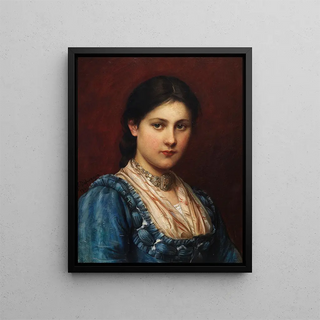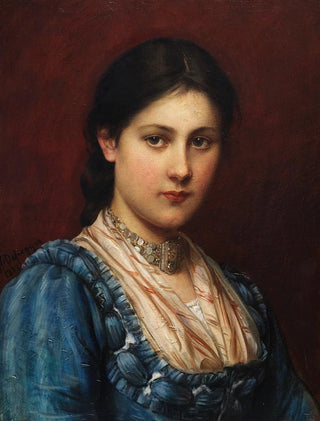Art print Girl in dirndl - Franz von Defregger | Art print


View from behind

Frame (optional)
In the rich and vibrant universe of art, some works manage to capture the essence of a time, a culture, and an emotion. "Fille en dirndl - Franz von Defregger" is one of those creations that, through its apparent simplicity, reveals the depth and complexity of everyday life. This painting, with its central subject, a young girl dressed in a traditional dirndl, evokes images of rural life in Austria at the end of the 19th century. The gaze of the young woman, both innocent and thoughtful, invites the viewer to delve into her world, to feel the nuances of her existence. The art print of this work not only allows appreciation of the scene's beauty but also immerses one in an atmosphere filled with nostalgia and tradition.
Style and uniqueness of the work
Franz von Defregger's style is distinguished by his ability to blend realism with a touch of romanticism. In "Fille en dirndl," the precision of the details immediately catches the eye. The textures of the clothing, the nuances of the colors, and the carefully manipulated light create an almost tangible atmosphere. The artist manages to bring his subject to life, to make the softness of the dirndl fabric felt, and to evoke the scent of flowers that might surround her. The composition, though simple, is highly effective, highlighting the natural beauty of the young girl while integrating elements of her environment. Every brushstroke seems to tell a story, that of a youth rooted in tradition yet open to a changing world.
The artist and his influence
Franz von Defregger, born in 1851, was an Austrian painter whose work was marked by the influence of the realist movement. His ability to capture moments of everyday life, particularly those of Austrian peasants, earned him a prominent place in the hearts of art enthusiasts. Defregger does not merely reproduce scenes; he imbues them with palpable emotion, a sense of belonging to a place and a time. His work was also influenced by the social and cultural changes of his era, and

Matte finish

View from behind

Frame (optional)
In the rich and vibrant universe of art, some works manage to capture the essence of a time, a culture, and an emotion. "Fille en dirndl - Franz von Defregger" is one of those creations that, through its apparent simplicity, reveals the depth and complexity of everyday life. This painting, with its central subject, a young girl dressed in a traditional dirndl, evokes images of rural life in Austria at the end of the 19th century. The gaze of the young woman, both innocent and thoughtful, invites the viewer to delve into her world, to feel the nuances of her existence. The art print of this work not only allows appreciation of the scene's beauty but also immerses one in an atmosphere filled with nostalgia and tradition.
Style and uniqueness of the work
Franz von Defregger's style is distinguished by his ability to blend realism with a touch of romanticism. In "Fille en dirndl," the precision of the details immediately catches the eye. The textures of the clothing, the nuances of the colors, and the carefully manipulated light create an almost tangible atmosphere. The artist manages to bring his subject to life, to make the softness of the dirndl fabric felt, and to evoke the scent of flowers that might surround her. The composition, though simple, is highly effective, highlighting the natural beauty of the young girl while integrating elements of her environment. Every brushstroke seems to tell a story, that of a youth rooted in tradition yet open to a changing world.
The artist and his influence
Franz von Defregger, born in 1851, was an Austrian painter whose work was marked by the influence of the realist movement. His ability to capture moments of everyday life, particularly those of Austrian peasants, earned him a prominent place in the hearts of art enthusiasts. Defregger does not merely reproduce scenes; he imbues them with palpable emotion, a sense of belonging to a place and a time. His work was also influenced by the social and cultural changes of his era, and
12,34 €






